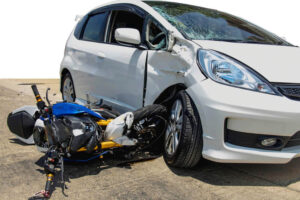There are often many misconceptions about the right of way and who has it, especially when it comes to motorcyclists. That is why in the below post, to help clear up some of these issues, we will go over the rules regarding right of way, whether motorcycles always have it, and the legal option is to get help by a motorcycle accident lawyer if you have been harmed in an accident because another driver violated these rules.
Do Motorcycles Always Have the Right of Way?
Motorcycles do not always have the right of way. Like other motor vehicles, they must follow the rules of the road. Bikers cannot force their way into traffic and expect other vehicles to allow them to get through. However, this also means that other motorists must yield to motorcycles when they do have the right of way.
What Does It Mean to Yield to the Right of Way?
Generally, when you yield to the right of way, you are letting another person or vehicle go before you. However, because many drivers do not understand this rule, they do not follow this rule of the road as they should, and as a result, they can cause crashes.
For example, if you arrive on your motorcycle at a stop sign at the same time as another driver at a cross street and your bike is on their right, you should give the other driver the right to proceed first. On the other hand, if you come up to an uncontrolled intersection at the same time as another automobile, the rider or driver who reached the intersection second is the one who should yield the right of way.
When Do Motorcyclists Have the Right of Way?
While the right of way laws do not grant a particular motorist the right of way, these laws do detail when a motorist must yield the right of way to others on the road.
Consider the following instances when to yield the right of way to other motorists and pedestrians as laid out by SafeMotorist:
- At a yield sign
- When an individual is using a white cane
- When an individual has a seeing-eye guide dog
- When pedestrians are in a crosswalk
- At an uncontrolled intersection where vehicles are already present
- At a T intersection, where other riders and drivers need to yield to vehicles on the through road
- When returning to the road after a vehicle was just parked
- When driving on an unpaved street that intersects with a paved road
- When turning left, the vehicle that is turning needs to yield to oncoming vehicles, bikers, and pedestrians
Yet, while these regulations are to prevent deadly crashes, fatal accidents still happen. This is usually because other drivers are distracted, negligent, or impatient while driving. They may also not understand the right of way rules or decide to ignore them, such as turning left without checking for oncoming drivers, motorcyclists, or crossing pedestrians.
However, if you suffered harm in a motorcycle crash because another driver failed to yield to your bike, consider contacting an experienced motorcycle accident attorney as soon as possible. These attorneys can review the facts of your accident, determine if you have a legal claim you can pursue and help you fight for the justice and financial damages you deserve.
How Do You Know Which Vehicle Has the Right of Way?
 Determining which vehicle has the right of way can be challenging in some situations.
Determining which vehicle has the right of way can be challenging in some situations.
While the driver or rider who arrives at a stop sign first should proceed through the intersection first, other scenarios make this right of way more challenging to figure out.
- Merging: The motorist or rider who occupies the road first has the right of way, meaning if another driver wants to change lanes or merge into that lane, the driver or rider already occupying the lane has the right of way.
- Parking space: If a motorist wants to pull out of a parking space, the rider or driver already in the lane has the right of way.
- Highway on/off ramps: Drivers on an access ramp must yield to vehicles traveling on the exit ramp. However, vehicles that are getting onto a highway must yield to all traffic coming up behind them.
- Construction vehicles and emergency vehicles: Vehicles must always yield the right of way to construction vehicles, construction workers, and emergency vehicles.
Failing to yield to the right of way increases the risks of vehicles colliding with other drivers, pedestrians, cyclists, and motorcyclists. That is why a rider or driver should never assume the other drivers understand these right of way rules and should always check before proceeding with a turn or a merge.
What Happens When Vehicles Do Not Respect Right of Way Rules?
Unfortunately, when drivers do not respect the right of way rules, it can lead to catastrophic motorcycle accidents, especially when motorcyclists are cut off, ignored at a four-way stop, or when motorists fail to check blind spots or use turn signals.
As a result, some of the more common accidents that tend to result from these right of way violations include:
- Rear-end accidents: Rear-end accidents often result when a motor vehicle bumps into a motorcycle from behind. These collisions occur when a driver is not paying attention, fails to yield, speeds, or tailgates.
- Intersection accidents: When a driver does not yield during a left turn to motorcyclists, it can lead to a tragic collision.
- Sideswipe accidents: When two vehicles travel in the same direction, one vehicle may hit the other at a point where lanes merge or while changing lanes. This usually happens when one vehicle fails to yield to the right of way, causing a sideswipe accident.
Although right of way accidents can lead to extensive losses and injuries, when these accidents involve a motorcyclist, the consequences can be devastating and even result in death. Even those who survive this tragic crash can have countless expenses and astronomical medical bills.
For these reasons, no matter what type of motorcycle accident you were involved in, if another motorist failed to give you the right of way and caused your crash, consult with an experienced motorcycle accident attorney as soon as possible and determine the legal options you may have.
Monetary Damages Available Following a Right-Of-Way Accident
If you sustained severe harm in a motorcycle crash because another driver did not yield the right of way, you might recover compensation:
Economic Damages
Economic damages usually refer to payment for the verifiable losses that result from an accident.
They include:
- Lost income and earning capacity
- Medical bills related to doctor visits, surgeries, hospital stays, ambulance services, emergency medical treatment, rehabilitation therapy, and prescriptions medications
- Future medical expenses
- Personal property costs, including bike repair or replacement expenses
- At-home replacement services because you can no longer complete certain activities by yourself after the accident, such as child-care services, grocery shopping services, or even cleaning services
- Other costs resulting from the accident
Non-economic Damages
Non-economic damages refer to payments for the hard-to-quantify losses that develop after an accident.
These losses include:
- Pain and suffering
- Disfigurement and scarring
- Loss of companionship
- Loss of enjoyment of life
- Mental anguish
- Loss of a limb
- Inconvenience from not being able to enjoy the activities you did before the accident
Punitive Damages
Unlike damages that compensate a victim for their harm, the court only awards punitive damages to punish the wrongful party and deter them and others from committing this behavior. To obtain these damages, you need a lawyer who can establish that the defendant acted remarkably recklessly or maliciously.
Consequently, if you want to know which damages you can pursue following a right of way motorcycle accident, speak to an experienced motorcycle accident attorney as soon as possible. A legal professional can review your accident, determine which damages apply to your case, and go after the financial damages you deserve.
Actions to Take After a Motorcycle Right of Way Accident
Even though taking any action after a motorcycle accident is probably the last thing on your mind, the steps you take after an accident ensures you get the help you need and protects your legal rights.
For these reasons, after a crash:
Call 911
You or someone around you should call 911 and alert the officials of the accident and your injuries. The police officers will also investigate the accident and jot down their conclusions regarding what happened in their police report. If you pursue legal action, your attorney can use this report to help strengthen your case.
Get Medical Help
Even if your injuries appear minor, you should still get to a doctor and get examined. Depending on the injury, it can take some time for symptoms to manifest, but the longer you wait to get treated, the more debilitating the condition can become.
In addition, these medical professionals can offer you a report detailing the severity of the trauma you suffered from the accident and provide a link between the car crash and your injuries. This can be beneficial if the other side claims that the accident was not the source of your harm or that your injuries were not that serious.
Reach out to a Motorcycle Accident Attorney
Once you get medical attention, consider contacting a motorcycle accident attorney as soon as possible. A lawyer can provide the legal services you require during this challenging time.
They can promptly investigate your accident and start gathering evidence to corroborate your claim, including photos of the vehicles involved, the damage to these vehicles, the placement of these vehicles on the road, skid marks on the street, and traffic lights or other signals nearby. This evidence can help your attorney determine what happened and who caused the accident.
Consult an Experienced Motorcycle Accident Attorney After a Right of Way Accident and Fight for the Remedies You Deserve

Andrew Finkelstein Motorcycle Accident Lawyer in New York
If you or a loved one endured severe injuries in a right of way motorcycle accident, you might be entitled to monetary recovery. However, consider speaking with an experienced motorcycle accident lawyer as soon as possible to go after these financial damages.
Your legal professional can not only review your accident in detail and figure out if you have a valid legal claim but they can also:
- Review your questions and concerns, and determine the legal actions you can take next.
- Investigate your right of way accident and gather evidence to show what happened, who was at fault, and the extent of your injuries.
- Bring specialists, such as accident reconstructionists, who can help prove liability by recreating the accident.
- Deal with the insurance companies and fight for the fair settlement you deserve.
- File a lawsuit before the statute of limitations expires, if necessary.
- Take your case before a judge or jury and go after maximum financial recovery if the other side refuses to get you the money you need.
For more information regarding right of way accidents and your legal rights after a motorcycle accident, contact a personal injury attorney in New York for a free case evaluation and learn how these legal professionals can help you fight for the compensation you deserve.
